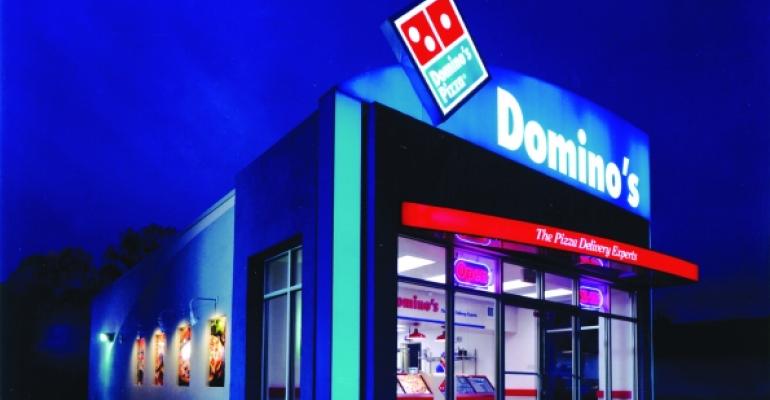Domino’s on Monday became the nation’s largest pizza chain to offer a gluten-free product — except the new item may not be a viable option for those most at risk from eating gluten.
Available in all of Domino’s nearly 5,000 U.S. locations, the gluten-free pizza crust option is made from rice flour, rice starch and potato starch. It does not contain wheat, rye or barley, the three sources of gluten protein that can cause health problems for those with celiac disease and people who are gluten-sensitive.
The new pizza, however, is not recommended for those with celiac disease because of possible cross-contamination in restaurants, Domino’s said.
Because the pizzas are made in the same kitchens as pizzas with a wheat crust, gluten could be introduced to the gluten-free product. Even microbial amounts of gluten can negatively affect the digestive system of someone with celiac disease.
However, those with milder versions of gluten sensitivity could enjoy the pizza, Domino’s said, as well as consumers who choose gluten-free diets because they believe them to be healthful.
Hear more about Domino’s gluten-free crust; story continues below
Domino’s worked with the National Foundation for Celiac Awareness, or NFCA, in developing the product.
The pizza chain is one of the first to undergo a new credentialing program launched by the foundation two weeks ago to help restaurants understand the needs of gluten-sensitive customers, and to help those customers identify menu options they can eat safely.
J. Patrick Doyle, Domino’s president and chief executive, said in a statement, “Many of our customers have asked for a gluten-free crust, and Domino’s is excited to offer a product to customers with mild gluten sensitivity — as well as partner with the NFCA, which has been instrumental to our learning more about how to take this step.
“The prevalence of gluten sensitivity has become a real issue with significant impact on consumer choice, and we want to be part of the solution,” he continued. “Now, the whole group can enjoy Domino’s with the addition of our new gluten-free crust.”
RELATED:
• A look behind Domino’s marketing strategies
• Domino's sets sights on domestic growth
• Domino’s: U.S. unit growth starts with better unit margins
Alice Bast, NFCA’s president, said the gluten-free trend has become big business for restaurant operators, but many still don’t understand what it means for a dish to be gluten free.
“I’ve been served salmon and couscous as a gluten-free menu option. Couscous is a wheat product. It’s not gluten free,” she said. “Restaurants are saying they can accommodate it, but they don’t recognize it as a medical condition.”
Under the new NFCA credentialing program, called GREAT Kitchens, restaurants can do online training that would help them understand the ingredients that contain gluten, the risks of cross contamination and how seriously it can impact the health of certain guests.
GREAT stands for Gluten-Free Resource Education Awareness Training. Those who complete the training would be able to use a symbol on their menu designating products as meeting standards for certain people with gluten sensitivities.
The new Domino’s pizza has earned an Amber designation under the NFCA’s program, which means the product is suitable for the gluten sensitive, but not necessarily those with celiac disease.
Domino’s front-of-the-house staff has been trained to make it clear to guests who order the pizza that it is not appropriate for those with celiac disease. Those who order it online must acknowledge a disclaimer to complete their order.
A truly gluten-free product is prepared in a way that would prevent cross contamination could earn a Green credential by NFCA, indicating it is “celiac friendly,” Bast said.
Only 1 percent to 2 percent of the U.S. population is thought to have celiac disease, a genetic autoimmune disorder that can cause serious digestive damage and can lead to cancer, Bast said.
Another 6 percent — or 18 million Americans — are considered gluten sensitive. Little is known about this group, but it includes people who have various reactions from eating gluten, such as migraine headaches or stomach pain.
A growing number of people feel it’s just healthier to avoid gluten. An estimated 15 percent to 25 percent of consumers say they are looking for more gluten-free options, Bast said.
When Bast was diagnosed with celiac disease 19 years ago, most restaurants had never heard the phrase “gluten free.” Now, she said, many see it as another fad or the “next new thing.”
“You have got to do this the right way or not at all,” she said.
Bast tasted a version of Domino’s new pizza made during training under conditions that prevented cross-contamination, and she pronounced it “delicious.”
But, she said, “I will not eat it at one of the restaurants because they can’t guarantee that it’s gluten free because of the possible cross-contamination.”
Contact Lisa Jennings at [email protected].
Follow her on Twitter: @livetodineout





